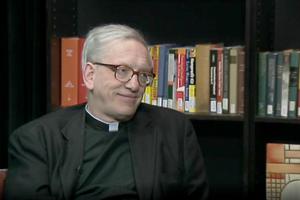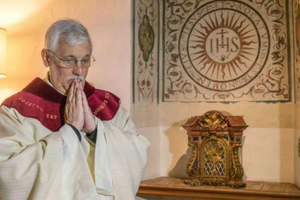The Jesuit Reform That Never Happened
COMMENTARY: Forty years later, the papal correction Pope St. John Paul II directed at the Society of Jesus still hasn’t taken hold.

Forty years ago on New Year’s Eve there was heightened anticipation in Rome, even tension, for the singing of the Te Deum — the Church’s traditional hymn of thanksgiving to God — at the conclusion of the civil year.
What would St. John Paul II say at the end of 1981? Would he comment upon the assassination attempt in May, or the declaration of martial law in Poland in December?
Those tragic topics were not the source of tension. The issue that had everyone on tenterhooks was the turmoil in the deeply troubled Society of Jesus.
John Paul kept the custom of traveling to the mother church of the Jesuits in Rome for the year-end Te Deum. The church, conceived by St. Ignatius himself, is known commonly as Il Gesù, but its complete title is The Holy Name of Jesus. Before the reform of the calendar, Jan. 1 was the Feast of the Holy Name of Jesus (it’s now Jan. 3), so Il Gesù was fitting place to keep vigil for the end of the Christmas Octave and the beginning of a new civil year. (Pope Benedict XVI moved the year-end Te Deum to St. Peter’s Basilica, and Pope Francis has kept it there. He visits Il Gesù for the feast of St. Ignatius in July.)
By 1980, the superior general of the Jesuits, Father Pedro Arrupe, was contemplating retirement and the calling of a general congregation of the Society of Jesus. John Paul was deeply concerned about the direction of the society, its high number of priestly defections, internal divisions, doctrinal confusion, liturgical abuses and moral turpitude. The Holy Father did not want a congregation called until some sort of correction was in place.
At the Te Deum at the end of 1980, Father Arrupe’s assistants cornered John Paul at Il Gesù, demanding progress on their desire to move ahead with a general meeting and election of a new superior general. John Paul demurred. A few months later he was shot, and in August 1981 Father Arrupe had a stroke that made his continuing as superior general impossible.
John Paul had to act. In October 1981 he gave his decision. It was an earthquake. The Holy Father suspended the ordinary governance of the Society of Jesus. Father Arrupe’s authority was given to a papal delegate, Father Paolo Dezza, who would govern until the Holy Father gave permission for a general congregation and election of a new superior. It was the greatest blow to the Jesuits since the order was supressed in 1773 by Pope Clement XIV.
“Life is religious orders was in crisis in the years after the Second Vatican Council, and while John Paul may not have thought that the Jesuits were worse off than others, he believed their influence was so great that a period of reflection was called for,” wrote George Weigel in Witness to Hope. “The intervention was shock therapy.”
Thus the Jesuits were traumatized — many of them enraged — when John Paul came to Il Gesù on Dec. 31, 1981. Tradition dictated that they host him at their principal church, housing the tomb of St. Ignatius and the precious relic of St. Francis Xavier, just months after his thunderous vote of non-confidence and evident lack of trust in their own capacity to reform themselves.
There were no fireworks at the Te Deum. John Paul did not speak about the Jesuits. He restricted himself to general comments on the passage of time, only alluding to the assassination attempt and the declaration of martial law:
“The year that is coming to an end today reconfirms this struggle [of death against life],” he said. “Doesn’t it reconfirm it within each of us? Does it not reconfirm it in the dimensions of life, societies and nations? Does it not reconfirm it in the dimensions of the entire globe?”
The anti-climactic Te Deum at the end of 1981 would presage the eventual resolution of John Paul’s intervention. He had acted with boldness, even severity, but he would leave it to the Jesuits to follow through on the path of reform.
At the general congregation eventually convoked in 1983, the Jesuits did not markedly change direction. They would continue to hemorrhage members and their orthodoxy and discipline did not markedly improve.
Pope Francis, recently meeting with Jesuits in Greece, noted that there were only half as many Jesuits as there were in his youth, and this was a “humiliation” for the society — a spiritually fruitful one, he hoped, but a humiliation nonetheless.
“We have to get used to humiliation,” the Holy Father said to his brother Jesuits.
Forty years after the shock therapy, under a Jesuit pope, the humiliation continues as the Jesuits shrink and shed apostolates. Though the Jesuits are led now by Father Arturo Sosa, their most prominent member is Father Antonio Spadaro and their most notable English-language personality is Father James Martin. The reform St. John Paul II had in mind did not take hold.
An epilogue to 1981, given that significant measures can often only be seen in hindsight:
The great papal correction of October 1981 was a failure. One of John Paul’s great papal successes would follow the next month, with the appointment of Cardinal Joseph Ratzinger as prefect of the Congregation for the Doctrine of the Faith on Nov. 25, 1981. Correcting errors would turn out to be less fruitful than proposing instead the splendor of the truth.
In hindsight, another seed planted in 1981 did bear fruit. Mother Angelica launched the Eternal Word Television Network in August 1981. Forty years on, Jesuits and their collaborators in the media made attacks on EWTN something of a favored theme in 2021. Who would have thought in 1981 that EWTN might do more to strengthen the faith of ordinary Catholics than the once-mighty, now humiliated, Jesuit order?
John Paul would not have known about EWTN at the Te Deum of 1981. He would come to know about it in time. But one notes that Christ, who is “The Eternal Word” did make it into his preaching that evening.
“The world seen in the Eternal Word — the world as a vestige imprinted by Divine Wisdom — is beautiful and it is good,” the Pope John Paul














